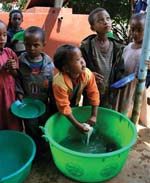Types of health behaviours
In this section, you will learn about six different types of health behaviour that people may perform — from the initial stages of preventing diseases up to their actions that may be associated with attempts to rehabilitate themselves after a bout of illness.

Preventive health behaviours: These are actions that healthy people undertake to keep themselves or others healthy and prevent disease or detect illness when there are no symptoms. Examples include handwashing with soap (Figure 3.1), using insecticide treated mosquito nets and exclusive breastfeeding to age six months.
Illness behaviours: These include any activities undertaken by individuals who perceive themselves to be ill. This would include recognition of early symptoms and prompt self referral for treatment. For example a person who feels that they are ill might visit the nearby health centre, while another person might go the church for a cure with holy water (tebel).
Sick-role behaviours: These include any activity undertaken by individuals who consider themselves to be ill, for the purpose of getting well. It includes receiving treatment from medical providers and generally involves a whole range of potentially dependent behaviours. It may lead to some degree of exemption from one's usual responsibilities. For example a person who feels that he is ill might visit the nearby health centre and receive tablets to be taken home, and might then not do as much work as normal.
Compliance behaviours: This means the person will be following a course of prescribed treatment according to the instructions that the health worker has given them.

Utilisation behaviours: This is the sort of behaviour that is described when people use their health services such as antenatal care, family planning, immunization, taking a sick person for treatment (Figure 3.2), etc.
Rehabilitation behaviours: This is what people need to do after a serious illness to get themselves better and prevent further disability.
Think of one example of each of the health behaviours in the list above.
There are, of course many examples. Below we list a few for each behaviour. As you will have realised from doing this ITQ the range of health behaviours is broad and varied.
Preventive: Eating a balanced diet, exclusive breast feeding for the first six months of life, drying swampy areas in the village to prevent malaria.
Illness: Consulting with the doctor or other health worker, taking a pain killer if you have a headache.
Sick role: Ceasing work, withdrawing from family life temporarily.
Compliance: Washing your hands after going to the latrine as suggested by the health worker; taking your medicine regularly in the case of HIV/AIDS.
Utiliisation: Might include using antenatal care, family planning or immunization services and also the use of services such as HIV testing or voluntary counselling and testing (VCT) services.
Rehabilitation: Practising walking after injuring your leg or practising talking after a stroke.